Describe an astigmatism - Study guides, Class notes & Summaries
Looking for the best study guides, study notes and summaries about Describe an astigmatism? On this page you'll find 297 study documents about Describe an astigmatism.
Page 3 out of 297 results
Sort by
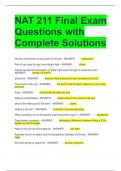
-
NAT 211 Final Exam Questions with Complete Solutions
- Exam (elaborations) • 17 pages • 2024
-
Available in package deal
-
- $14.99
- + learn more
NAT 211 Final Exam Questions with Complete Solutions Mucous membrane covering part of the eye - ANSWER conjunctiva Part of eye used for day vision/bright light - ANSWER cones Cranial nerves that stimulation of taste buds travel through to cerebral cortex - ANSWER nerves VII and IX glaucoma - ANSWER occurs if fluid pressure of eye increases too much The cones in the eye - ANSWER are part of retinal layer, respond to red, green, and blue Pupil - ANSWER a hole that lets light into eye ...
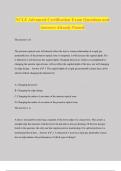
-
NCLE Advanced Certification Exam Questions and Answers Already Passed
- Exam (elaborations) • 186 pages • 2024
- Available in package deal
-
- $15.49
- + learn more
NCLE Advanced Certification Exam Questions and Answers Already Passed The answer is D. The posterior optical zone will directly affect the lens to cornea relationship of a rigid gas permeable lens. If the posterior optical zone is steepened, it will increase the sagittal depth. If it is flattened, it will decrease the sagittal depth. Changing the power, which is accomplished by changing the anterior optical zone, will not affect the sagittal depth of the lens, nor will changing its edge d...

-
Midterm Final Study Guide for Exam Preparation. Revised Edition
- Exam (elaborations) • 11 pages • 2024
- Available in package deal
-
- $8.49
- + learn more
What term describes the infestation of lice? Pediculosis What type of tissues lines blood and lymph vessels? Endothelium What does the term actinic keratosis refer to? abnormal growth of skin cells what characteristics define astigmatism? curvature of the eye what bacterium causes chlamydia? Chlamydia trachomatis What bacteria causes necrotizing fasciitis? what are some of it's properties? Group A strep bacteria red warm, swollen skin. Later can cause ulcers, blisters and black spot...
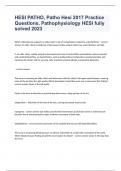
-
HESI PATHO, Patho Hesi 2017 Practice Questions, Pathophysiology HESI fully solved 2023
- Exam (elaborations) • 71 pages • 2023
- Available in package deal
-
- $27.99
- + learn more
HESI PATHO, Patho Hesi 2017 Practice Questions, Pathophysiology HESI fully solved 2023 Which rationale best supports an older client's risk of complications related to a dysrhythmia? - correct answer An older client is intolerant of decreased cardiac output which may cause dizziness and falls In an older client, cardiac output is decreased and a loss of contractility and elasticity reduces systemic and cerebral blood flow, so dysrhythmias, such as bradycardia or tachycardia is poorly toler...
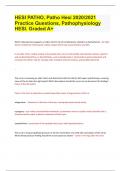
-
HESI PATHO, Patho Hesi 2023/2024 Practice Questions, Pathophysiology HESI. Graded A+
- Exam (elaborations) • 71 pages • 2023
- Available in package deal
-
- $12.99
- + learn more
Which rationale best supports an older client's risk of complications related to a dysrhythmia? - An older client is intolerant of decreased cardiac output which may cause dizziness and falls In an older client, cardiac output is decreased and a loss of contractility and elasticity reduces systemic and cerebral blood flow, so dysrhythmias, such as bradycardia or tachycardia is poorly tolerated, and increases the client's risk for syncope, falls, transient ischemic attacks, and possibly...
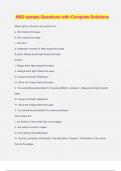
-
ABO sample Questions with Complete Solutions
- Exam (elaborations) • 22 pages • 2024
- Available in package deal
-
- $12.49
- + learn more
ABO sample Questions with Complete Solutions When light is refraction by a prism it is: a. Bent toward the apex b, Bent toward the base c. Not bent d. Reflected -Answer-B. Bent toward the base A prism always bends light toward its base. Prisms: I. Always bend light toward the base II. Always bend light toward the apex III. Cause chromatic Dispersion IV. Move the image toward the apex V. Are sometimes prescribed for muscle problems -Answer-I. Always bend light toward base III. Cause...
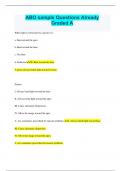
-
ABO sample Questions Already Graded A
- Exam (elaborations) • 29 pages • 2023
-
Available in package deal
-
- $9.99
- + learn more
ABO sample Questions Already Graded A When light is refraction by a prism it is: a. Bent toward the apex b, Bent toward the base c. Not bent d. Reflected B. Bent toward the base A prism always bends light toward its base. Prisms: I. Always bend light toward the base II. Always bend light toward the apex III. Cause chromatic Dispersion IV. Move the image toward the apex V. Are sometimes prescribed for muscle problems I. Always bend light toward base III. Cause chromatic dispersion. IV. M...
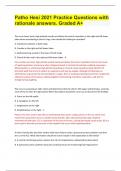
-
Patho Hesi 2023 Practice Questions with rationale answers. Graded A+
- Exam (elaborations) • 19 pages • 2023
-
- $9.99
- + learn more
The nurse hears short, high-pitched sounds just before the end of inspiration in the right and left lower lobes when auscultating a client's lungs. How should this finding be recorded? A. Inspiratory wheezes in both lungs B. Crackles in the right and left lower lobes C. Abdominal lung sounds in the bases of both lungs D. Pleural friction rub in the right and left lower lobes - B Fine crackles are short, high pitched sounds heard just before the end of inspiration that are the result of r...
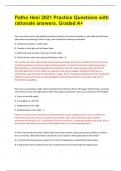
-
Patho Hesi 2023 Practice Questions with rationale answers. Graded A+
- Exam (elaborations) • 19 pages • 2023
-
- $9.99
- + learn more
The nurse hears short, high-pitched sounds just before the end of inspiration in the right and left lower lobes when auscultating a client's lungs. How should this finding be recorded? A. Inspiratory wheezes in both lungs B. Crackles in the right and left lower lobes C. Abdominal lung sounds in the bases of both lungs D. Pleural friction rub in the right and left lower lobes - B Fine crackles are short, high pitched sounds heard just before the end of inspiration that are the result of r...
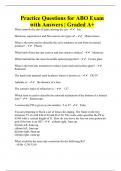
-
Practice Questions for ABO Exam with Answers | Graded A+
- Exam (elaborations) • 19 pages • 2023
-
Available in package deal
-
- $11.49
- + learn more
What controls the amt of light entering the eye - Iris Meniscus, equiconcave and flat concave are types of: - Minus lenses What is the term used to describe the eye's tendency to turn from its normal position? - Phoria What kind of lens has one convex and one concave surface? - Meniscus What material has the most favorable optical properties? - Crown glass What is the best lens treatment to reduce water and road surface glare? - Polarized The hard resin mater...

Did you know that on average a seller on Stuvia earns $82 per month selling study resources? Hmm, hint, hint. Discover all about earning on Stuvia


